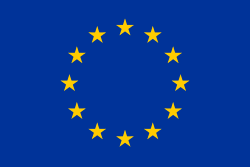草稿:欧洲象征

欧洲自古以来拥有许多象征符号,其中最著名的就是神话人物欧罗巴。1950至60年代,欧洲理事会引入几种标志;1985年,欧洲共同体为自己创建附加标志;1993年,欧洲联盟继承这些标志。现在,这些欧盟标志代表支持欧盟政策,以及欧洲人民倡导欧洲一体化的政治立场。
欧罗巴和公牛
[编辑]
古希腊时代,希罗多德将“Europa”用作地理术语,指已知世界的一大块领地;在当时认知的地理范围内,是指色雷斯或伊庇鲁斯的部分地区,这个用词也出现在荷马的阿波罗赞歌。罗马时代,两位影响颇大的地理学家斯特拉波和托勒密,将其用作塔纳伊斯以西大陆的地理术语。加洛林王朝时代,“欧罗巴”首次被用作为文化术语,指拉丁基督教世界的领土。
欧罗巴(Europa)是一个女性化名字,在赫西俄德作品中是一位女神的名字。同时,在希罗多德最早讲述的传说中,她是一位被希腊人(希罗多德认为是克里特人)绑架的腓尼基贵妇的名字。奥维德的古典著作《变形记》描述,欧罗巴不是被希腊海盗绑架,而是被变身公牛的宙斯诱拐。根据记载,宙斯变身为一头温顺的白色公牛,混在欧罗巴父亲的牛群,当欧罗巴和侍女正在采花时,她看见公牛并爬上公牛背,宙斯趁机跑到海里,带着她游到克里特岛。宙斯向欧罗巴透露自己的身份,令她成为克里特岛的第一位王后,并送给她一件赫淮斯托斯制作的项链,以及另外三份礼物:塔罗斯、莱拉普斯和万无一失的标枪。后来,宙斯在星空中创造白色公牛的形状,也即是群星的金牛座。

欧罗巴和公牛的起源神话自希腊-罗马时代以来,一直是欧洲艺术常见的主题,也经常被提及到与欧洲大陆和现代欧盟的关系;因此,它不仅被可以被视为地名学,也可以被视为欧洲象征或化身。例如,欧罗巴和公牛的雕像位于欧盟的几个机构,以及出现在希腊的2欧元硬币;欧洲议会保罗-亨利·斯巴克大楼的圆顶上,有一幅由阿利吉·萨苏创作的大型马赛克,描绘欧罗巴和公牛的场景,以及其他希腊神话元素。
除此之外,公牛图案也出现在所有欧盟国家新设计的居留证的左上角。[1]
欧洲女王
[编辑]
欧洲女王(拉丁语:Europa Regina)兴起于16世纪风格主义时期,是在地图绘制中将欧洲描绘成一位身着皇室礼服的女王形象。[2][3] 这份地图的罗盘方位西边朝上,伊比利亚半岛是头部,戴着形似加洛林帝国环冠的王冠;比利牛斯山脉是颈部,法国(高卢)构成上胸部;神圣罗马帝国(日耳曼尼亚和其他领土)是躯干的中心,波希米亚(早期描绘中有时是奥地利)是女王的心脏(或腰间的一枚勋章);她的长袍延伸至匈牙利、波兰、立陶宛、立窝尼亚、保加利亚、莫斯科、马其顿和希腊;她的手臂由意大利和丹麦组成,左手握着权杖、右手握着十字圣球(西西里岛)。[4] 大多数描绘只显现非洲、亚洲和斯堪的纳维亚半岛的边角,不列颠群岛也呈现示意图的形式。[4]
The first map to depict Europe in this manner was made by Johannes Bucius Aenicola (1516–1542) in 1537.[5][6][7] Though much about the origination and initial perception of this map is uncertain,[7] it is known that Putsch maintained close relations with Holy Roman Emperor Ferdinand I of Habsburg,[7][8] and that the map's popularity increased significantly during the second half of the 16th century.[7] Europa Regina was introduced in the 1530s by the Austrian cartographer Johannes Putsch, possibly with the intent of depicting Europe as the spouse of Charles V of Habsburg, who aspired to become the universal monarch of Christendom and reigned over numerous realms including the Holy Roman Empire, Austrian lands, Burgundian territories, and the kingdom of Spain.[4][8] Arguments in favour of this hypothesis are the westward orientation of the map to have Hispania as the crowned head, said to resemble the face of Charles V's wife, Isabella of Portugal; the use of the Holy Roman Empire's insignia – its Carolingian crown, sceptre and orb – and the portrayal of Habsburg realms (Austria, Bohemia, Hungary, Germany) as the heart and centre of the body; the design of the gown, which resembles the contemporary dress code at the Habsburg court.[9][8][4][10] As in contemporary portraits of couples, Europa regina has her head turned to her right and also holds the orb with her right hand, which has been interpreted as facing and offering power to her imaginary husband, the emperor.[10] More general, Europe is shown as the res publica christiana,[8] the united Christendom in medieval tradition,[4] and great[2] or even dominant power in the world.[10]
Another allegory is the attribution of Europe as the paradise by special placement of the water bodies.[8] As contemporary iconography depicted the paradise as a closed form, Europa regina is enclosed by seas and rivers.[8] The Danube river is depicted in a way that it resembles the course of the biblical river flowing through the paradise, with its estuary formed by four arms.[8] That Europa regina is surrounded by water is also an allusion to the mythological Europa, who was abducted by Zeus and carried over the water.[10] Europa regina belongs to the Early Modern allegory of Europa triumphans, as opposed to Europa deplorans.[11]
欧洲之父
[编辑]查理曼(拉丁语:Carolus Magnus)是法国和德意志君主制度的创始人,被誉为“欧洲之父”(Pater Europae)。[12][13] 他于公元800年建立加洛林帝国,是西罗马帝国覆灭以来欧洲最广泛的统一,并且带起形成泛欧洲身份的卡洛林文艺复兴,标志着古典晚期的终结。[12][14] 同时,当时的知识和文化复兴也深刻地影响西欧历史。赋予查理曼大帝超越其军事成就的传奇地位。[12][15][16]

几个世纪以来,欧洲王室一直试图与加洛林王朝的遗产联系。例如:神圣罗马帝国皇冠和拿破仑一世皇冠都被命名为“查理曼皇冠”;查理曼的私人宝剑“Joyeuse”,从11世纪开始被用作法国国王的加冕剑。[17] 法国文艺复兴作家让·勒迈尔·德·贝尔热进一步美化对查理曼的崇拜,他认为这位皇帝是著名的“皇权传递”的一部分,这是源于特洛伊战争时期的特洛伊国王普里阿摩斯,引申到希腊神话中的“众神与人类之父”宙斯。
现今查理曼大帝的泛欧象征价值,很大程度在于他被视为法德友谊的化身,这种友谊在两次世界大战期间的长期敌对状态中并不存在,但在欧洲一体化进程中却变得不可或缺。所以在1952年欧洲委员会旗帜设计竞赛中,好几个未能获得成功的设计方案,都让人联想到金焰旗;这是公元800年教皇良三世在圣彼得大教堂,为查理曼加冕时赠予的旗帜。[18][19] 同年,汉斯·冯·亨蒂希(Hans von Hentig)教授也指出,查理曼帝国与现代欧洲一体化之间存在相似之处。[20] 欧盟委员会还将布鲁塞尔的其中一座中心建筑,以查理曼的名字命名为查理曼大厦,以此来彰显查理曼大帝。1949年开始,德国亚琛每年都会向欧洲统一的贡献者颁发查理曼奖,获奖者包括阿尔契德·加斯贝利、让·莫内等人物。国际事务报刊《经济学人》的每一期刊物,都会开设一个名为“查理曼笔记”(Charlemagne's notebook)的专栏,重点关注欧盟事务。[21] 2010年,欧洲议会议长耶日·布泽克在查理曼青年奖颁奖典礼的讲话中说道:[22]
| “ | 请你想象一下,一千二百年前查理曼大帝的时代。那时,他就已经憧憬着一个统一的欧洲。想想从那时起发生了多少场战争,欧洲流了多少血。我们被仇恨吞噬,被情绪所左右,无法达成共识。当时人们憧憬着一个统一的欧洲,但却未能实现。我亲爱的年轻朋友们,我们必须牢记,永远铭记这一愿景。 | ” |
后来,也有一些君主被冠以“欧洲亲戚”的称号,例如:英国维多利亚女王(欧洲祖母)、丹麦国王克里斯蒂安九世和黑山国王尼古拉一世(两者均为欧洲岳父);然而,这些称号纯粹是得名于其后代子孙的联姻关系,并不具备更广泛的象征意义。
主保圣人
[编辑]罗马天主教会尊崇六位圣人为“欧洲主保”。1964年,教宗保禄六世册封努西亚的本笃为“全欧洲的主保圣人”。[23] 1980年至1999年期间,教宗若望保禄二世先后册封基里尔和美多德、彼济达、圣加大利纳和埃迪特·施泰因为共同主保。[24][25]
据信自14世纪初以来,整个欧洲大陆都被奉为欧洲圣母的庇护所。[26]
旗帜
[编辑]
欧洲委员会于1955年推出“欧洲旗”,最初旨在作为“整个欧洲的象征”。[27] 由于1985年欧洲经济共同体(EEC)采纳该旗帜,因此被作为EEC继承机构的欧洲联盟(EU)采纳,该旗帜如今与欧盟紧密相关,至少自2000年代初开始,它不再单纯具有代表“整个欧洲”的功能。21世纪初的颜色革命中,亲欧盟抗议者尤其选择挥舞该旗帜,例如:2004年白俄罗斯抗议活动[28]、2013年乌克兰亲欧盟派系在广场起义使用的旗帜,以及2016年英国去留欧盟公投运动中的亲欧盟派系。
1955年之前采用的泛欧旗帜
[编辑]

在欧盟政治制度发展之前,代表欧洲的旗帜仅限于统一运动,其中最受注目的是欧洲运动的联邦主义旗,旗帜设计为白底绿色大“E”,以及国际泛欧联盟(1922年)的“泛欧洲旗”(Pan European flag)。[29]
另见
[编辑]参考资料
[编辑]- ^ Demey, Thierry. Brussels, capital of Europe. S. Strange (trans.). Brussels: Badeaux. 2007: 387. ISBN 978-2-9600414-2-2.
- ^ 2.0 2.1 Landwehr & Stockhorst (2004), p. 279
- ^ Werner (2009), p. 243
- ^ 4.0 4.1 4.2 4.3 4.4 Werner (2009), p. 244
- ^ Bennholdt-Thomsen (1999), p. 22
- ^ Borgolte (2001), p. 16
- ^ 7.0 7.1 7.2 7.3 Schmale (2004), p. 244
- ^ 8.0 8.1 8.2 8.3 8.4 8.5 8.6 Wendehorst & Westphal (2006), p. 63
- ^ Europeanness in Early Modern Latin Literature, Isabella Walser-Bürgler, p. 60
- ^ 10.0 10.1 10.2 10.3 Werner (2009), p. 245
- ^ Werner (2009), pp. 243ff
- ^ 12.0 12.1 12.2 Riché, Preface xviii, Pierre Riché reflects: "[H]e enjoyed an exceptional destiny, and by the length of his reign, by his conquests, legislation and legendary stature, he also profoundly marked the history of Western Europe."
- ^ Der Karlspreisträger Seine Heiligkeit Papst Johannes Paul II. außerordentlicher Karlspreis 2004. Karlspreis.de. [2012-01-01]. (原始内容存档于17 January 2012).
- ^ Home – Humanities Division – UCLA. Humanities Division – UCLA.
- ^ karlspreis.de. karlspreis.de. [2012-01-01]. (原始内容存档于17 January 2012).
- ^ Chamberlin, Russell, The Emperor Charlemagne, p. ???
- ^ Coronation sword and scabbard of the Kings of France, Decorative Arts : Early Middle Ages, Louvre
- ^ Proposals for European flags from Arsène Heitz (1952–1955). cvce.eu. 8 November 2011 [2013-08-06].
- ^ Proposals for European flags from Arsène Heitz (1952–1955). cvce.eu. 5 January 1952 [2013-08-06].
- ^ 'Charlemagne and coke' from the Frankfurter Allgemeine Zeitung (5 January 1952). cvce.eu. [2013-08-06].
- ^ «Must try harder». The Economist.
- ^ europarl.europa.eu. europarl.europa.eu. 11 May 2010 [2012-01-01].
- ^ Johan Fornäs, Signifyingo Europe (2012), p. 255f.
- ^ Egregiae Virtutis. [26 April 2009]. (原始内容存档于4 January 2009). Apostolic letter of Pope John Paul II, 31 December 1980 (拉丁语)
- ^ Johan Fornäs, Signifyingo Europe (2012), p. 255f.
- ^ Gibraltar Our Lady of Europa 20p. www.westminstercollection.com. [2020-04-30]. (原始内容存档于3 March 2020) (英语).
- ^ The European flag, Council of Europe. Retrieved 27 October 2016.
- ^ Mite, Belarus: Scores Arrested, Opposition Leader Hospitalized After Minsk Protests, rferl.org, 20 October 2004 [5 August 2007])
- ^ CVCE (编), The European flag: questions and answers, [25 June 2014]
外部链接
[编辑]- The symbols of the EU – Europa
- Council of Europe Logo and the European Flag – Council of Europe
- Why the European flag has been chosen: Resolution (55) 32 adopted by the Committee of Ministers of the Council of Europe (8 December 1955) – CVCE (Previously European NAvigator)
- The European Anthem and downloads – Council of Europe
- European anthem – CVCE (Previously European NAvigator)
- European commission poster – CVCE (Previously European NAvigator)
- The European emergency number 112 – European Emergency Number Association (EENA)
- The European emergency number 112 – European Commission
- Europe's name – A website on illustrations of Europa in relation to the Continent
- The Symbol's Role in the Creation of a European Identity – A dissertation paper.



